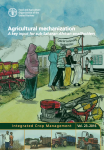The Agriculture and Consumer Protection Department of the Food and Agriculture Organization of the UN (FAO) has released a report outlining strategies and approaches to support agricultural mechanization in sub-Saharan Africa.
The report relays challenges to mechanization, describes its potential benefits and provides recommendations for action towards an integrated and sustainable approach.
 29 September 2016: The Agriculture and Consumer Protection Department of the Food and Agriculture Organization of the UN (FAO) has released a report outlining strategies and approaches to support agricultural mechanization in sub-Saharan Africa. The report relays challenges to mechanization, describes its potential benefits and provides recommendations for action towards an integrated and sustainable approach.
29 September 2016: The Agriculture and Consumer Protection Department of the Food and Agriculture Organization of the UN (FAO) has released a report outlining strategies and approaches to support agricultural mechanization in sub-Saharan Africa. The report relays challenges to mechanization, describes its potential benefits and provides recommendations for action towards an integrated and sustainable approach.
The report, titled ‘Agricultural Mechanization: A key input for sub-Saharan African smallholders,’ shows that sustainable mechanization is important to achieving Sustainable Development Goal (SDG) 2, which aims to “end hunger, achieve food security and improved nutrition and promote sustainable agriculture.” Among other arguments, the report notes that two thirds of farm power in sub-Saharan Africa is provided by human might, which is the highest rate among all regions in the world. Replacing some of that energy outlay with mechanization could unlock significant improvements in productivity while also improving the conservation of resources and increasing climate resilience, the publication notes.
The first two chapters of the report outline the context of agricultural mechanization and challenges faced in sub-Saharan Africa, including: lack of affordability due to a lack of access to financial products, low yields and lack of market access; lack of availability due to a vicious circle of low demand leading to low supply; lack of farmer skills; private sector constraints such as weak machinery importation and distribution networks; and gender issues, in particular that investments to reduce the labor burden for women do not fall within social norms.
Chapter three discusses opportunities for mechanization in the region, including: raising framer incomes through sustainable intensification and commercialization to increase affordability and demand; creating new opportunities by supporting innovation for energy-efficient and sustainable mechanization concepts, developing climate-smart agriculture, and developing new sustainable business models; public-private partnerships; and supporting investment in agricultural mechanization.
The final chapter provides suggested actions for a way forward. It recommends integrating agricultural mechanization in pan-African policy frameworks, such as the Comprehensive Africa Agricultural Development Programme (CAADP) framework of the New Partnership for Africa’s Development (NEPAD) and the African Union (AU). It also suggests the development of sustainable agricultural mechanization strategies that integrate on-farm and off-farm applications in order to achieve sustainable mechanization along the entire agri-food chain including resource conservation, waste avoidance, and creation and maintenance of rural infrastructure.
Another recommendation focuses on educating farmers and building capacity in using mechanization towards “greening agriculture” such as through FAO’s farmer field school approach. Further recommendations address the need to: develop specific business models that improve the integration of smallholders in modern food systems and markets; identifying models of mechanization that provide economic advantages for smallholders; producing social advantages through mechanization such as reduced risk, diversified income sources, and improved infrastructure; and developing approaches that support women.
A final set of recommendations addresses: institutional and organizations’ arrangements to support smallholder mechanization; fostering private-sector development and south-south cooperation; field-based capacity building; and establishing regional centers of agricultural mechanization. [FAO Press Release] [UN Press Release] [Report Abstract] [Publication: Agricultural Mechanization: A Key Input for Sub-Saharan African Smallholders]